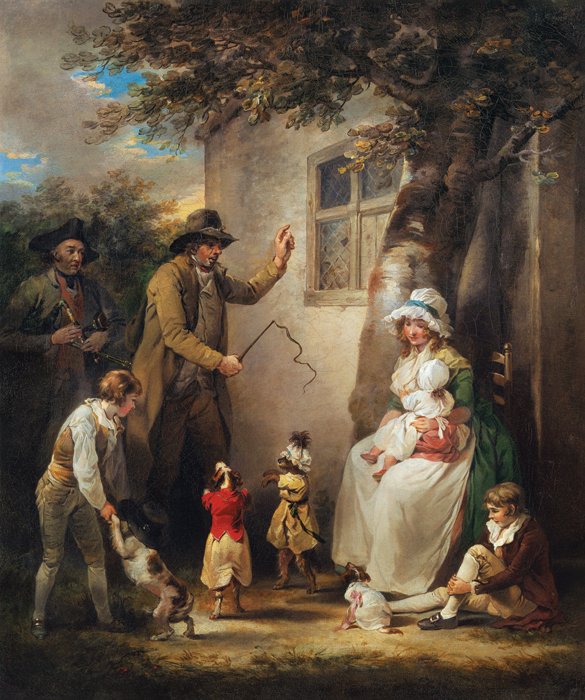Attributed to George Morland, Dancing Dogs,
c. 1790. Oil on canvas, 76.2 x 63.8 cm.
The Metropolitan Museum of Art, New York.
Benjamin West executed approximately four hundred paintings, including painted sketches. His most popular works are those in which, renouncing the traditions of high art, and the imitations of the Lombardy school, he gave himself up to representing subjects from contemporary history, The Battle of La Hogue, Penn’s Treaty with the Indians, and The Death of General Wolfe. West owed the public favour that he enjoyed during his lifetime entirely to royal patronage. There is not a picture by this honoured President of the Academy that would be received at this day into any private gallery, however mixed it might be.
One must do him the justice of saying that he was bold enough to introduce modern costume into the representation of contemporary history. He was the first to admit it into modern art. His Death of General Wolfe is his most praiseworthy work, but even in this quite modern line (not historical painting, but historical genre painting on a large scale) he has been surpassed by John Singleton Copley[7], whose Death of Major Pierson is infinitely superior. Copley had acquired a certain reputation in Boston. He travelled to Italy in 1774, and on his way passed through London, where he returned for good at the end of the same year.
What shall we say of the Anglo-Swiss Henry Fuseli[8]? In 1782, he exhibited The Nightmare at the Royal Academy, of which institution he became an associate in 1788, member in 1790, and professor in 1799. Several of the subjects of his pictures were taken from Milton’s poems. He published a new edition of Pilkington’s Dictionary of Painters, and translated Lavater’s treatise on physiognomy into English.
William Etty, of Lombard Street, began his studies at Somerset House. The following year he was introduced to Fuseli, and admitted as an Academy student. As his ambition was to receive lessons from Lawrence, his uncle paid a hundred guineas for his admittance for a year into the celebrated portrait painter’s studio. But the master, who was full of other engagements, troubled himself little about his pupil. At the expiration of the time so dearly paid for, Etty studied from nature, and copied the old masters at the British Institution. He was a most assiduous student of the Academy, which treated him with great severity, for year by year the pictures that he sent to the exhibitions were ruthlessly rejected until 1820. In 1822, he visited Venice, Florence, Rome, and Naples. Venice particularly charmed him, and in his autobiography he speaks of it as “Venice, the cradle of colour, the hope and idol of my artist life”. Returning to London in 1823, he exhibited Pandora Crowned by the Seasons. This picture caused him to be elected associate of the Royal Academy. He was made a member in 1828. Etty’s ambition was to be a moralist painter.
“In all my works,” he wrote, “I have endeavoured to exercise a moral influence on the public mind. In the Battle I have striven to depict the beauty of mercy; in Judith patriotism and self-sacrifice to one’s country, one’s people, and one’s God; in Benaiah, David’s Lieutenant, courage; in Ulysses and the Syrens, resistance to passion, or a Homeric paraphrase on the text, ‘The wages of sin is death’; in Joan of Arc, religion, loyalty, and patriotism.” His best works are the least assuming and the least moral, as Youth and Pleasure, The Lute Player, and The Duet, in which he shows a pleasing sense of colour.
James Northcote prided himself on being an artist, critic, biographer, writer of fables, and brilliant talker, all at the same time. We are only concerned with him here in his character of artist. He has left numerous portraits and pictures of the historical genre species; among others, The Children of Edward, Mortimer and Richard Plantagenet, and The Death of Wat Tyler for Boydell’s Shakespeare Gallery. He also laid claim to painting animals better than anybody else.
West, Fuseli, Etty, and Northcote maintain a violent emulation amongst themselves of exaggerated tints, extravagant gestures, and follies of all sorts. Pray let us pass on. The genre painters whom we are going to study possessed, at least, intelligence; the others are simpletons, only now and then ceasing to be absurd when they free themselves from their solemn trappings and condescend to be natural. Let us return to Hogarth.
